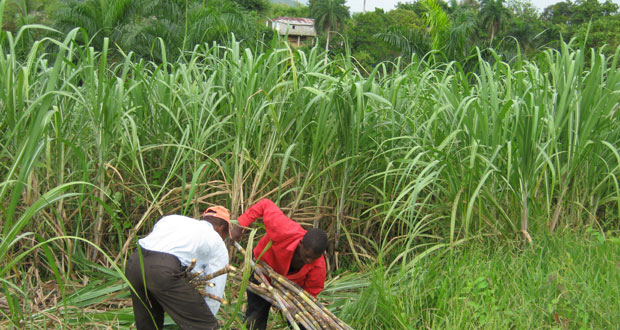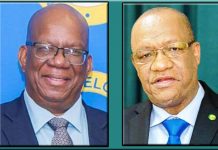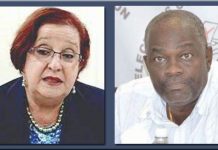As the non- agronomist sugar novice and newly minted CEO of GUYSUCO, Sasenarine Singh, tells us of his mission…
“Well to get back into sugar production, that’s the bottom line….
And, if we were uncertain why this recommends him, he appends
‘but what we want to do is to move more up the value chain into packaged sugar”.
Hmmm.
Jagdeo’s vicarious 2nd third term has begun as no surprise.
When he was ejected from office through Ramotar, he was an indecent violator of the national treasury and a consistently corrupt contractor of agreements with foreign countries, particularly China, which never alleviated the plight of squatters, as the Pradovilles multiplied in number and labels of socio economic blight stuck even harder.
Now he’s back through Irfaan, a satellite President so porous in self assuredness that the foreign community recognized him for his esteem vacancy.
And as an unreformed thug, pillager of natural resources and plunderer of the Treasury, Jagdeo’s Guyana is back to Sugar Talks…no irony on sugar.
The studied opinions of the professionals with knowledge of Guyana’s soil, its ratoon and plant crop, tell us unequivocally that, with status quo, the resurrection of sugar will fail, even on Easter Sunday…
And let’s say with all humility, we’re neither expert nor novice.
But Jagdeo has consistently pledged transparency and almost as frequently, slipped that self-imposed leash of honesty.
So, if expertise is to be ascribed just chalk it up to revisiting sugar, its decline and what’s being said in the name of sugar, now that the motivation is, once again, the treasury as a spoil of ethnic dominance.
A compact but historic panorama of post-colonial sugar in Guyana would take us to 1972- the Non Aligned gathering in Georgetown, Guyana headed by then President Burnham and the resulting Georgetown Agreement which embodied the formation of the African, Caribbean, and Pacific countries (ACP).
We’ll revisit the remit of the ACP, that of creating collective bargaining for these, now independent colonies, that would go beyond the UK’s Lomé Convention which was established to wean the colonies from the economic comfort of selling 69% of their exports and buying 58% of imports from the European Economic community. It was a convenience that spared Guyana the price skirmishes of dealing in the competitive market.
We’ll find that its decade old precursor was the 1962 General Strike called by Richard Ishmael, of Trade Union Council TUC, as a response to Cheddi Jagan’s threat to fire all civil servants for not paying a luxury tax on salaries of BG$100, which disproportionally impacted Afro Guyanese who, largely, occupied those jobs.
We’ll see that the target was hardly coincidental since Jagan’s base claimed not to meet the BG$100 monthly because they were mere farmers and since they made their own bush rum, they escaped the luxury tax attached to liquor purchase. We got Black Friday from that move which festered and inflamed into to the 1963 80 day strike, again under Cheddi Jagan.
The common thread through these strikes was Jagan’s base in 1962 and his Union, Guyana Agriculture Workers Union (GAWU) which consisted mostly of his base.
Weaponizing the concept of numbers, GAWU was pitted against the Man Power Citizens Association, MPCA, an anti – PPP sugar estate conceived union which Jagan felt would vote for him, if they were given secret ballot.
Consolidating GAWU and MPCA would give him control of the sugar industry and the power over agriculture.
It’s the kind of insidious power grab that became the defining characteristic of him, his Party and its politics.
Short history but long story that places sugar with the 1838 arrival of its Indian indentured laborers, its evolution in to a political chess piece through the control of still largely Indian sugar workers in the 1960’s and the imperative to keep the industry afloat as a place of employment for the descendants of those original workers – mostly because they aligned with PPP ideology in its pursuit of transforming Guyana into Jung Bahadur Singh’s fantastic ‘New India’ – and largely because their numbers were great enough to be victorious in the first past the post electoral system, that all but assured a PPP victory by virtue of their percentage of population.
Now its 2020 and talks of the resurgence of sugar have begun as a matter of ideology more than economy because none of the structural impediments to bringing the revived product into realistic and competitive production have been mentioned…not even in error.
What structural impediments you ask?
Well let’s look at the most fundamental, for starters.
And, we’ll go to the current vicarious leader to back us up on this one.
Way back in 2005, when Bharrat’s Guyana had dueling economies of drugs and commodities, he was forced to, sometimes, play country overseer and say things to prop up that persona.
In an interview with Financial Times, he let us know that he knew that the agricultural arm of the sugar industry was related inextricably and dependent fiercely on an elaborate drainage and irrigation system that alleviated coastal flooding because of its sub sea level…and he emphasized the need for its maintenance, as a parallel industry agency.
Under his watch, nevertheless, the sugar industry collapsed epically and in linear fashion – as if to punctuate that its decimation was not an inherent deformity but one that was emblematic of a an Administration that calculatedly mismanaged the financial assistance it secured to ‘save the industry’.
That would explain why agencies like the IDB underscores PPP government “corruption and lack of accountability…discrimination and insufficient attention to decentralization” in its 2002-2006 country evaluation in which total debt of Guyana to the IDB represented 59% of GDP (pg 6 program & delivery)
Cynical reference in the 2002 Programming Mission Report CP-2402-1 of Jagdeo “requested further clarification of the relationship between CIPE methodology and the new lending scenario” is almost punctuated with a giggle…as diplomacy tries to record what they describe as an overall lack of agility in financial oversight.
We can go through the litany of loans and programs that PPP Governments secured to pump into a Sugar Industry, which served more as political ideology and employment agency for its base supporters than it did to contribute meaningfully to the National GDP, since its cost of production never really serviced the debt or translated into competitive market product …as supported by Chris Ram when he was a noble warrior for country and not Party, who knew that 40 cents per pound could never compete with say, Thailand’s 18 – 23 cents per pound.
Can’t not mention the distraction of efforts the PPP made to improve the sugar industry -from courting Iran to deploying Irfaan to transfer GYD 4 billion as an advance to pay for a 17,000-unit housing development – the prepayment of the billions ostensibly for ‘enhanced sugar production‘…none of which happened. ..no house, no increased sugar.
And we would be remiss if we didn’t mention the dying- gasp diversion of funds through the Skeldon Sugar Factory built by a Chinese Car import company, ‘China National Import and Export Corporation’ which quickly malfunctioned…maybe because it was built with car parts…then repaired by South Africa’s Bosch Engineering to offer palliative care at the cost of 1.8 million…they say, then shuttered after a professed attempt at economic CPR and irreconcilable expenditure of the GYD billions.
We can hear the naysayers rushing to ask why mention of the preceding is necessary.
To this we respond…at no point in the Post Subsidy era of Guyana’s sugar crop did Jagdeo, in any of his vicarious Presidencies overseeing the multiples of millions poured in to the industry, focus on what he knows is critical to realistic and competitive production by Guyana’s sugar Industry – the elaborate drainage and irrigation system that would alleviate coastal flooding – a co-requirement for successful sugar industry endeavors.
Now, post 2020 election interference, Sugar is en vogue again and again sans drainage and irrigation.
And since the recurring decimal in this calculation of sugar is Jagdeo, we have to look at what he brings this time around.
There’s Irfaan, we know, who had his indictments discharged because laws prohibit the indictment of Presidents while in office. That makes him a thief who sits in the office of President.
And this new head of GUYSUCO, this Sasenarine Singh, comes with the blemishes that Jagdeo just seems to surround himself with as some sort of governing garnish.
In 2011, Jagdeo, in his signature viper style, publicly decried Sasenarine as a thief – one who “was fired five times from five different places for ‘teefin’”
That came after Sase seemed to have grown tired of his unrewarded stream of praises for Jagdeo …even likening him to a god– which had to make the devil mad– and before his foray into the AFC, where he all but offered a lap dance to be the head of GUYSCO, should the Coalition win.
His skill set was not a pre-requisite there so his overtures were ignored.
Now, he’s Jagdeo’s Sugar Daddy… selected for a proficiency that is mightily rewarded under the PPP.
After all, stealing 5 times from 5 different places does suggest a sliminess that comports well with Jagdeo …once referred to as a hypocrite by the international community …in gentile euphemism for crook.
We’ve been here before.
We were here during the PPP’s sustained thrust of Guyana into a painful reckoning with their relentless raids on the national treasury, without corresponding benefits for the majority.
We remember the Robert Persaud declaration that Nanda Gopaul would “present a blueprint of success that will detail strategies over the next two to three years” designed to turn GUYSUCO around.
That was 2009.
There was no turn around and Chris Ram captures the state of the floundering industry in his ……“the now fired CEO of the Corporation had said that the Corporation needed $16B to avert an industry-wide shutdown.
Yet, the Granger Government could not risk a shutdown of the industry..“
All this to illustrate the proximity to terminal illness that the Sugar Industry suffered during the PPP, which runs mismanagement and misappropriation as an administrative relay.
Now we have Sasenarine, a 5 time thief from 5 different places, tapped to meet another target, another goal, another prediction by the PPP which seems to have a grab bag of these things sitting in the proverbial corner, waiting to pelt as answers to declining incomes and disappearing jobs.
Those of us who remember the gyrations that this Sase previewed, when begging for this GUYSUCO job during his political street walking with AFC, are as insufficiently impressed with his capabilities now, as we were then…especially because he lacks the acumen and particularly because he has begun his job with the bluster of a BLUFFUS, citing “packaging” operations that have been deemed burdensome …and by Chris Ram …once a respected caped crusader for propriety and not Party.
And on top of all this, no one, not even vicarious leader Jagdeo, has alluded to drainage and irrigation as an imperative here …the component that is critical to the prevention of crop inundation during rains, now heavier with climate change.
We’ll be neither surprised nor disappointed when this becomes just another term of PPP treasure hunting at the Treasury.
Just disgusted.






I agree with what you’ve written and as you basically indicated it was more political to revive the sugar industry (to please/shore up his base) rather than for economic beneficiary reasons. I believe Jagdeo’s thinking is “I don’t care if the sugar industry fails, the oil industry will more than make up for this failed sector”. And I believe this is the position the Granger’s administration should’ve taken! Who knows, they might have still been in power if they had done so (of course with many other factors lining up!).